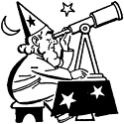Pair (of pants, etc.)
Two to tango.
Dear Word Detective: We live in the country and have a pond nearby, so I purchased some inexpensive binoculars to watch egrets, herons, beavers and the other wildlife. I emailed a friend telling him that we’d bought a pair of binoculars and asked parenthetically why we call them a pair when there’s only one. He shot back: FOR THE SAME REASON WE CALL THEM A PAIR OF PANTS (he likes to shout in his emails.) So why do we call them pairs — binoculars, pants, glasses, shorts and probably others — when they’re single units? — Barney Johnson.
Although your friend types in annoying capital letters, he is essentially correct in his answer, and “a pair of pants” is a good illustration of this peculiar “pair” phenomenon.
 What we now call “pants” or “trousers” were originally known as “pantaloons,” after Pantalone, a stock character in 16th century Italian commedia dell’arte (theatrical comedy) usually portrayed as an old man wearing short, baggy pants. The Anglicized form “pantaloon” soon appeared in English meaning “a foolish old man” (as in Shakespeare’s “lean and slippered pantaloon” from As You Like It), but the term was also applied to the Pantalone style of trousers, eventually giving us the shortened form “pants.” But “pants” in the 16th century differed from today’s jeans in that each leg was a separate garment, donned in succession and then belted together at the waist. Thus it made sense to call these “two-piece britches” a “pair” of pants, and the usage stuck long after pants were unified. We speak of “a pair” of shorts or swimming trunks because of the precedent set by “pants.”
What we now call “pants” or “trousers” were originally known as “pantaloons,” after Pantalone, a stock character in 16th century Italian commedia dell’arte (theatrical comedy) usually portrayed as an old man wearing short, baggy pants. The Anglicized form “pantaloon” soon appeared in English meaning “a foolish old man” (as in Shakespeare’s “lean and slippered pantaloon” from As You Like It), but the term was also applied to the Pantalone style of trousers, eventually giving us the shortened form “pants.” But “pants” in the 16th century differed from today’s jeans in that each leg was a separate garment, donned in succession and then belted together at the waist. Thus it made sense to call these “two-piece britches” a “pair” of pants, and the usage stuck long after pants were unified. We speak of “a pair” of shorts or swimming trunks because of the precedent set by “pants.”
In the case of “a pair of binoculars,” the progression from separate to unified was much quicker, but “pair” still stuck. “Binoculars” were developed within just a few years of the invention of the first telescope in the early 17th century, when folks realized that a “binocular” (literally “two-eyed”) view through a telescope would be better than the close-the-other-eye-and-squint method. So they literally bolted two small matched telescopes together, and the “binocular telescope” was born. “Pair of binoculars” makes even less sense than “pair of pants,” since “binocular” already contains the concept of “two,” but that’s English for you. Oddly enough, the “monocular” (“mono” meaning “one”), a single small telescope (also known today as a “spotting scope”) wasn’t called that when “binoculars” were invented, and the term “monocular” didn’t come into use until the early 20th century. Speaking of “monocular” brings us to the “monocle,” a single corrective lens worn squeezed between the brow and cheek, fashionable in the 19th century. The past popularity of the lone monocle is the reason we find it necessary to speak of a “pair of glasses” today.
There are other “pairs” out there, including some that have never been used in single form, such as “tongs,” “tweezers” and “scissors,” but in such cases “pair” simply carries the sense of something made of two joined or corresponding parts, both of which are needed for the thing to function.
Page 1 of 2 | Next page
